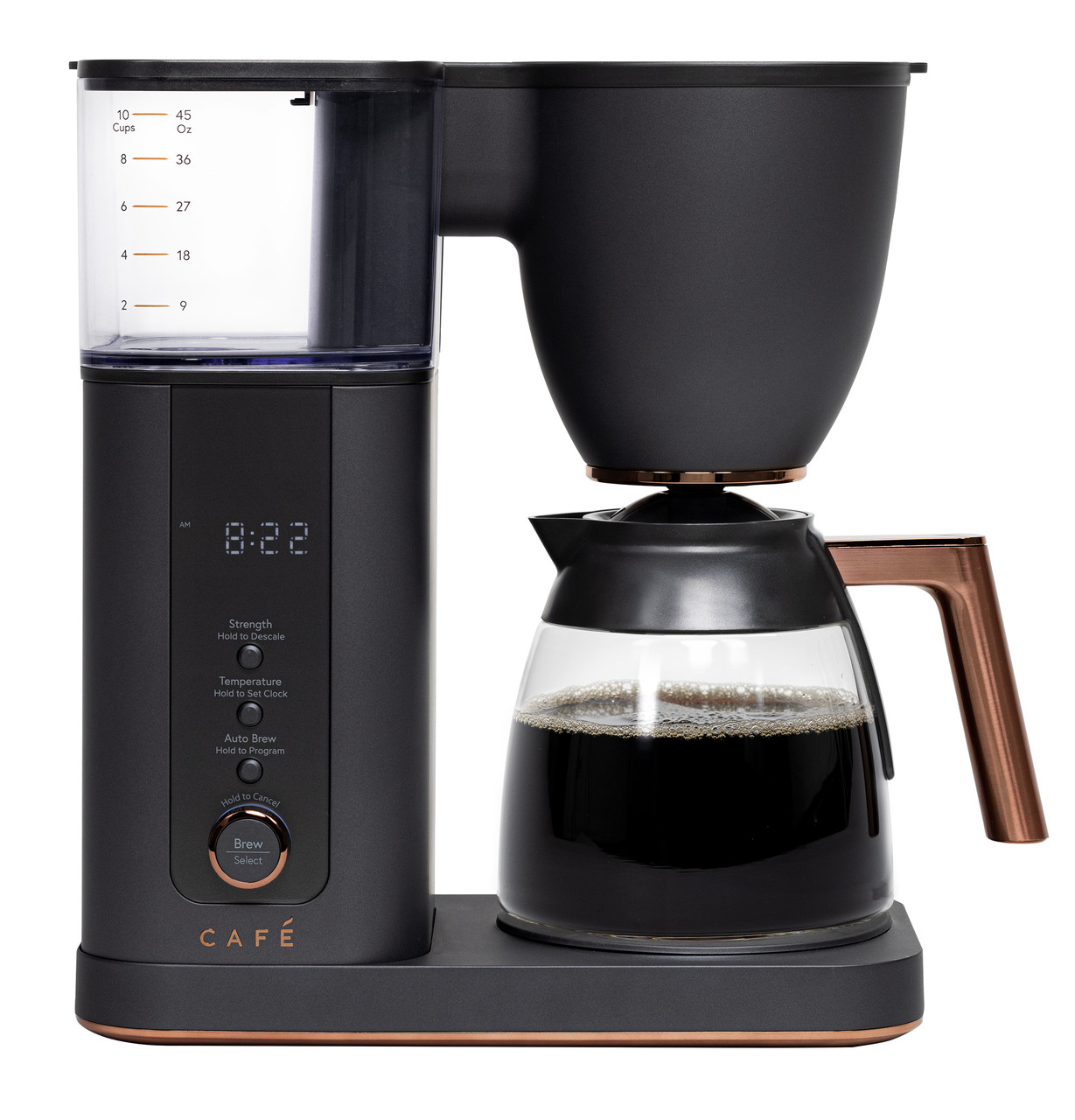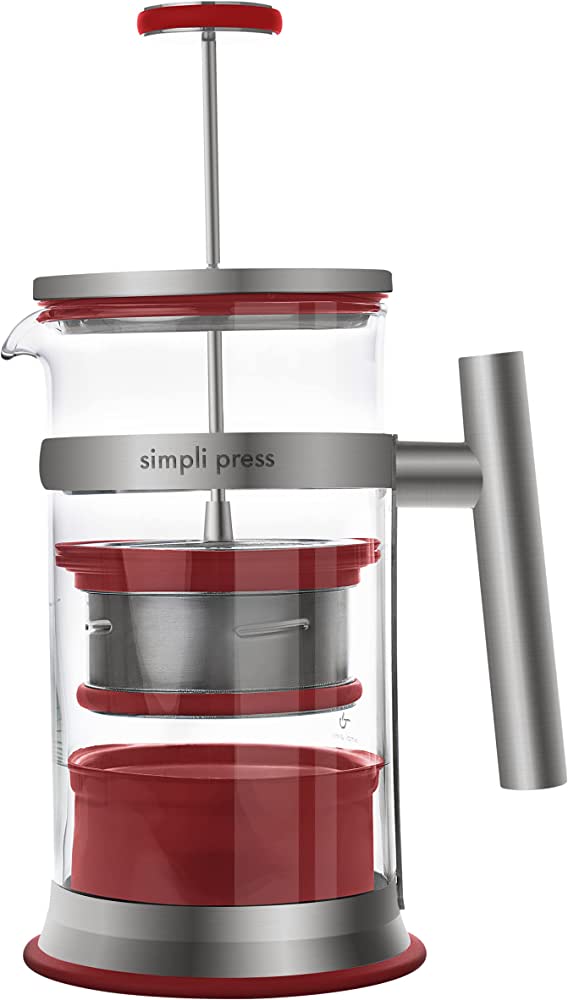Plastic free coffee makers are environmentally friendly and reduce the environmental impact of single-use plastics. These machines are becoming increasingly popular as they provide a sustainable option for coffee lovers.
Not only are they eco-friendly, but they also produce high-quality coffee without the need for disposable pods or filters. Additionally, many plastic-free coffee makers are also aesthetically pleasing and durable, making them a long-term investment. The market offers a variety of options, including french presses and pour-over coffee makers.
By opting for a plastic-free coffee maker, consumers can contribute to reducing plastic waste and promoting sustainability.

Credit: www.cafeappliances.com
The Environmental Impact Of Plastic Coffee Makers
Discuss The Negative Environmental Impact Of Plastic Coffee Makers
Plastic coffee makers have become a common household item; they are convenient, time-saving, and easy to use. However, the impact on the environment is immense. The following are the key points to consider:
- Plastic waste: Plastic coffee makers are made up of different types of plastic, which are not biodegradable. Plastic waste takes hundreds of years to decompose, and it releases toxic substances, which contaminates the soil and water bodies.
- Energy waste: The usage of plastic coffee makers often coincide with the use of disposable cups, these cups are a significant contributor of energy waste as they require additional energy to recycle or decompose.
- Carbon footprint: The manufacturing of plastic coffee makers releases a vast amount of greenhouse gases, which contribute to rising global temperatures and climate change.
Provide Statistics And Facts About Plastic Waste And Its Impact On The Environment
The statistics related to plastic waste are alarming, and the impact on the environment is severe. The following are a few relevant facts:
- According to the united nations, around 100,000 marine animals are killed due to plastic entanglement each year.
- Around eight million tonnes of plastic enter the oceans every year, resulting in 1.6 million square kilometers of ocean covered in plastic debris.
- Plastic waste in the ocean harms the marine ecosystem and is responsible for the death of millions of marine animals.
- Plastic waste exposure can cause several health problems, including cancer, birth defects, and neurological disorders.
Explain How Switching To A Plastic-Free Coffee Maker Can Help Reduce Plastic Waste
Switching to a plastic-free coffee maker is a small but significant step towards reducing plastic waste. The following are the key points that back the idea:
- Durability and reusability: Plastic-free coffee makers are often constructed from stainless steel or glass that are durable, dishwasher safe, and reusable. They tend to last longer and cause fewer issues for future generations.
- Eco-friendly: Most plastic-free coffee makers are made from materials that are biodegradable. They decompose more quickly and naturally than plastic and release fewer harmful chemicals.
- Reduce carbon footprint: Using a non-electric coffee maker like a french press, espresso maker, or pour-over coffee maker, significantly reduces energy consumption, thus decreasing the carbon footprint.
Switching to a plastic-free coffee maker provides numerous benefits for the environment, your health and the economy. It is an excellent way to reduce plastic waste and promote sustainable living practices.
Types Of Plastic-Free Coffee Makers
Coffee lovers rejoice! You can now enjoy a cup of coffee and save the environment at the same time. Plastic-free coffee makers are not only eco-friendly but also a healthier alternative to plastic makers. Here are three types of plastic-free coffee makers you can choose from:
Stainless Steel
Stainless steel coffee makers are durable and easy to clean. They can also retain heat for a longer period than glass or ceramic makers. However, they are often more expensive than glass or ceramic, which may put some people off.
Also, stainless steel coffee makers are not transparent, so you cannot see the coffee brewing inside.
Recommended for: if you’re looking for a long-lasting and easy-to-clean maker and don’t mind spending a few extra bucks.
Glass
Glass coffee makers are transparent, allowing you to watch the coffee brewing inside. They are also easy to clean and do not retain any flavors or odors from previous brews. However, glass coffee makers are more fragile and may break easily.
They also do not retain heat as well as stainless steel or ceramic makers.
Recommended for: if you prefer a transparent maker and do not mind the delicate nature of glass.
Ceramic
Ceramic coffee makers are heat-resistant and can retain heat better than glass. They do not affect the taste of coffee and are easy to clean. However, they are heavy and may break easily if dropped. Ceramic coffee makers may also be more difficult to find than stainless steel or glass makers.
Recommended for: if you like to enjoy your coffee for extended periods and aren’t worried about mobility.
The choice between stainless steel, glass, or ceramic is primarily based on personal preference and budget. We recommend the stainless steel maker for long-lasting and easy-to-clean options, glass for those who enjoy transparency, and ceramic for extended coffee drinking. By opting for a plastic free coffee maker, you are not only making a responsible decision but also paving the way for a greener future.
Keywords: Plastic Free Coffee Makers
Features To Consider When Choosing A Plastic-Free Coffee Maker
Are you looking for a way to incorporate sustainability into your morning routine while still enjoying your daily dose of caffeine? Consider switching to a plastic-free coffee maker! Not only are these coffee makers better for the environment, but they also offer a range of benefits that make them a worthy investment.
Here are some features to consider when choosing a plastic-free coffee maker:
Material
When selecting a plastic-free coffee maker, be sure to choose a model that is made from durable materials such as stainless steel or glass. These materials not only promote durability but also eliminate the risk of harmful chemicals leaching into your coffee.
- Stainless steel: Stainless steel is an excellent choice for a coffee maker, as it is durable and long-lasting. It is also easy to clean and maintain.
- Glass: A coffee maker with a glass carafe is another great option. Glass is non-porous, so it won’t absorb any odors or flavors from coffee over time. Plus, it’s a sustainable and recyclable material.
Filters
Coffee filters are a necessary component of brewing coffee, but traditional paper filters can contribute to unnecessary waste. Opting for a coffee maker with a reusable filter is a sustainable way to reduce your impact on the environment.
- Metal mesh filter: A metal mesh filter is a perfect choice for a plastic-free coffee maker. It is durable, long-lasting, and easy to clean.
- Cloth filter: A cloth filter is another excellent option. It can be washed and reused, reducing the amount of waste produced by traditional paper filters.
User-Friendliness
Ease of use is another crucial factor to consider when purchasing a coffee maker, especially if you’re trying to streamline your morning routine. Look for a model that has a simple design and is easy to clean.
- Simple design: A coffee maker with a simple design is less likely to break or malfunction. Plus, it’s easier to use on a busy morning when you’re rushing out the door.
- Easy to clean: A coffee maker that is easy to clean will save you time and frustration. Make sure to choose a model that comes with clear cleaning instructions.
By investing in a plastic-free coffee maker, you’re making a conscious effort to reduce your environmental footprint and promote sustainability. Choosing a model made from durable materials, with reusable filters and a straightforward design, will make your morning routine both eco-friendly and effortless.
How To Care For Your Plastic-Free Coffee Maker
Plastic-free coffee makers: how to care for and dispose of them responsibly
Revolutionize your kitchen by switching to plastic-free coffee makers. Not only are they environmentally friendly, but they also produce a better taste in your coffee. However, it is essential to properly clean and dispose of them to ensure they last for a long time.
Provide Tips On How To Properly Clean And Care For Plastic-Free Coffee Makers To Ensure Longevity
Proper care is key to ensure the longevity of your plastic-free coffee maker. Here are some tips to clean and care for it properly:
- Clean it after every use to prevent any build-up of leftover coffee grounds and residue.
- Use vinegar or a coffee maker cleaner to descale and remove any mineral build-up.
- Run a mixture of water and vinegar through the coffee maker twice a month to remove any unpleasant odors.
- Do not place it in the dishwasher as doing so can damage the parts.
Explain How To Dispose Of Plastic-Free Coffee Makers Responsibly When They Are No Longer Usable
When your plastic-free coffee maker is no longer usable, it’s essential to dispose of it responsibly. Here are some ways to do it:
- Check with your local recycling center if they accept plastic-free coffee maker parts for recycling.
- Donate it to a local coffee shop if they have an active recycling program.
- Disassemble and reuse the parts to make other household items.
- Donate it to a secondhand store or sell it online.
Revolutionize your morning routine by switching to a plastic-free coffee maker. With proper care and responsible disposal, you can enjoy both the perfect cup of coffee and contribute to the environment.
Frequently Asked Questions Of Plastic Free Coffee Makers
How Does A Plastic-Free Coffee Maker Benefit The Environment?
A plastic-free coffee maker reduces the amount of plastic waste that ends up in landfills and oceans, helping to protect the environment. Because plastic can take centuries to break down, reducing plastic use is an important step in preserving the planet.
What Are The Alternatives To Plastic Coffee Makers?
Alternatives to plastic coffee makers include stainless steel, glass, and ceramic. These materials are reusable, durable, and non-toxic, making them a safer and more sustainable choice.
Are Plastic-Free Coffee Makers More Expensive Than Plastic Ones?
While some plastic-free coffee makers may be more expensive initially, the long-term cost savings make them a worthwhile investment. Additionally, the environmental benefits of reducing plastic waste make the extra cost well worth it.
How Do You Clean A Plastic-Free Coffee Maker?
Cleaning a plastic-free coffee maker is similar to cleaning a plastic one. Simply rinse the parts with warm, soapy water and dry thoroughly. If needed, use a gentle scrub brush to remove any stubborn residue.
Can You Use Paper Filters With A Plastic-Free Coffee Maker?
Yes, paper filters can be used with plastic-free coffee makers, provided they are the correct size and compatible with the maker’s design. Alternatively, some makers come with reusable metal filters that eliminate the need for disposable paper filters altogether.
Are Plastic-Free Coffee Makers Easy To Use?
Yes, plastic-free coffee makers are generally easy to use, with a simple design that allows for easy brewing. With a little practice, you can quickly master the art of brewing delicious, plastic-free coffee.
Conclusion
Coffee is an inseparable part of our daily routine, and it’s high time we start taking steps to reduce our environmental footprint. Using plastic-free coffee makers is a small yet significant contribution towards a greener planet. The use of eco-friendly coffee makers is a smart choice not just for the environment but also for our health.
These plastic-free coffee makers do not leach any harmful chemicals into our coffee, ensuring a safer and healthier cup of brew. The best thing is that these coffee makers come in various materials like steel, glass, and clay, giving us the freedom to choose the one that aligns with our individual needs and preferences.
So let’s switch to plastic-free coffee makers and make a conscious effort in preserving our planet for future generations to come. Together, we can make a difference, one cup at a time.

